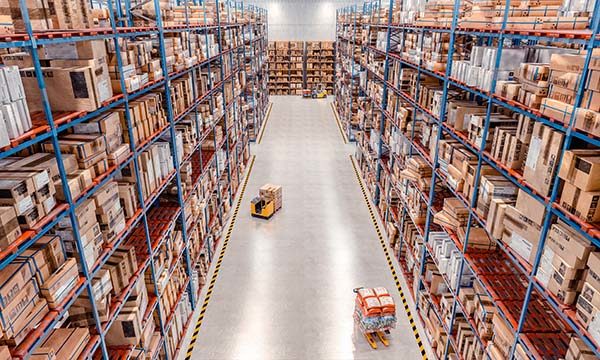Storage rack fundamentals
Product design, warehouse needs, and long-term demands reign supreme in designing the best racking system for the modern warehouse.

Robotics and automation may be all the rage in warehousing circles these days, but the building blocks of the modern warehouse haven’t strayed far from their roots. Storage racks—the traditional, nonautomated kind—are a prime example and an often overlooked aspect of today’s fast-moving, high-tech facilities. These warehouse staples can help maximize storage space, speed throughput, and create a safer work environment in facilities of all shapes and sizes—provided you have the right system in place to meet your needs.
Wondering how to choose the right storage racking for your warehouse—or determine if your current system is the right one? These three steps can help guide the way.
STEP 1: UNDERSTAND RACK FUNDAMENTALS
In warehousing and logistics, industrial storage racks typically hold pallets, cases, and large individual items that will be picked, packaged, and shipped. Some of the most common types of racks include:
- Selective racking. This type of rack is used to store pallets in either single- or double-deep modes. Single-deep racks allow full pallets to be stored side by side, so that all pallets are accessible from the warehouse aisle. Double-deep options increase storage density by allowing two pallets to be stored back to back.
These are some of the simplest racks available and are often used in warehouses that store a high number of different stock-keeping units (SKUs), but a low volume of each SKU, according to Diane Domingues, vice president of marketing and customer service for rack manufacturer Frazier Industrial Co. She describes selective rack as “a great solution for any industry, especially those with changing needs.”
- Case- or carton-flow racking. This type of racking consists of shelves equipped with rollers or wheels that allow cases or cartons of product to flow forward as they are picked. Domingues explains that it is “used to store SKUs fulfilled in case- or each-based increments. It’s commonly seen in food, beverage, and retail applications, [but] it can be a solution for any industry with slow-moving SKUs stored in case- or each-based increments as part of its product mix.”
- Pallet-flow racking. These racks allow for higher-density storage, and they work much like case-flow racking does. Pallets are loaded from the rear of the system and move forward along a pitched track of wheels. When a pallet is removed, the remaining loads roll forward. Such systems are commonly used in first-in/first-out (FIFO) storage applications, including in the food industry, according to Domingues.
- Drive-in racks. These are free-standing self-supporting racks that allow drive-in access to forklifts. Pallets are loaded and unloaded on horizontal rails that run along the inside of the racks, perpendicular to the warehouse aisles. Used to create high-density storage, these are best for high-volume, low-SKU applications, such as manufacturing, beverage, and food processing.
Drive-in rack systems are versatile and cost-effective, allowing products to be stored multiple-positions deep, which can “cut down on aisle space compared to other systems,” according to Eric Andres, national sales manager for rack manufacturer Hannibal Industries.
- Push-back racking. This high-density storage option is similar to drive-in racking and allows customers to store pallets up to five deep. It uses a series of carts on pitched tracks for loading and unloading. The first pallet to be stored in the system is loaded onto the top cart; the next pallet is used to push the first load back, exposing the next cart for loading. The process repeats until the last pallet is deposited into the system. When a pallet is unloaded, gravity moves the subsequent carts forward until all pallets have been picked. “Unlike drive-in, every push-back bay can store a different SKU, and all pallet access is done without entering the rack,” according to Domingues. The system is commonly used in food and cold storage applications.
- Cantilever rack. This type of system is used to store long products, such as pipes or lumber. A series of columns with arms are used to hold the products, which are often bundled together. Products are stored across the arms, allowing a forklift to pick up the load from the center. The racks can also be fitted with wire decking to allow storage of other types of products.
These systems are typically used in manufacturing and construction, and also by some specialty retailers such as hardware stores.
STEP 2: DETERMINE YOUR NEEDS
Because warehouses often store different types of products, with differing volume throughputs, the ideal storage solution often includes more than one type of racking. The first step to determining what you need is to review “unit, method, and area,” according to Domingues. Unit refers to the product load or loads being stored; method is the type of equipment being used to handle the products; and area refers to the space available in your warehouse for racking.
“Your answer to each question will dictate what types of racking are most [suitable] for your specific needs,” Domingues explains. “If you’re unsure what type of rack is best, a racking supplier can help you determine the ideal solution.”
Andres agrees, adding that it’s also important to work with a supplier who understands the rules and regulations for constructing racking systems. Such requirements are often guided by local building codes and can include seismic considerations, which vary by region, as well as safety measures that can help guard against system damage and worker injury.
“We think it starts with finding a trusted partner,” Andres says. “You need to look for someone who understands the requirements for the building space and how those needs may change over time. It’s also critically important that they understand local, state, and federal requirements for the building or warehouse space.”
STEP 3: DESIGN FOR THE LONG TERM
Customers used to select racking systems based on the here and now, but not anymore, Domingues and Andres agree.
“Once upon a time, buyers were selecting rack systems based on their immediate needs. When those needs changed, they bought new racking,” Domingues says. “Now, they are buying systems that take both their immediate needs and projected future needs into account. The modern warehouse can’t wait the time it takes to remove an old rack … and replace it with a new one, so buyers are thinking longer term, with resiliency in mind.”
Lately, that means designing systems that maximize storage capacity, largely in response to a tight warehousing market, according to Andres. Accelerating e-commerce activity, inflation, and a variety of other factors have combined to increase both demand for and the cost of warehouse space, so companies are looking to get the most out of new and existing facilities. Andres advises designing systems that optimize storage in a smaller warehouse footprint and free up space for picking and other value-added activities, for example.
He says seismic considerations are an important aspect of long-term design as well. Rack installers can reinforce their designs based on local building code requirements, and there are also specific rack products designed with seismic protections in mind. Hannibal Industries’ patented TubeRack system was designed specifically to withstand the dangers of earthquakes, for example.
“It’s really about designing a safer system,” Andres says.
Domingues agrees that safety is taking on a greater role in rack design today, especially when it comes to ergonomics and worker protection. Storage systems that provide easier access to items, for example, can help reduce injuries and increase productivity—two factors that also address the industry’s labor crunch by keeping workers on the job and maintaining the flow of products through the warehouse.
“Racks have grown to keep up with the needs and demands of the modern warehouse. They’ve become a lot more agile, adaptable, and flexible in their design to accommodate the ever-evolving warehouse environment,” Domingues says, emphasizing the need to focus on the safety aspect in particular. “There is a greater premium on worker, equipment, and product safety than ever before. And today’s racking solutions are designed with a greater emphasis on all of those [considerations].”
Related Articles

Copyright ©2024. All Rights ReservedDesign, CMS, Hosting & Web Development :: ePublishing